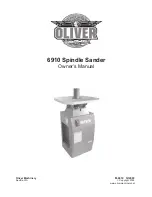
11
• Hearing protection
• Protective gloves against physical agents
• Anti-vibration gloves, to be worn following a specially conducted survey of the daily exposure of the hand-arm system to
vibration
• Protective mask against physical agents according to the values found in the environmental/industrial hygiene survey
- Make sure you are in a safe position, keeping proper balance at all times. A safe working position and a proper body posture
enable better control of the pneumatic tool in unexpected situations.
- Do not wear loose clothing or jewellery. Keep your hair, clothing and gloves away from moving parts. Loose clothing, jewellery,
and long hair can get caught in moving parts.
- Do not directly inhale the exhaust air, and prevent it from getting into your eyes. The exhaust air of the pneumatic tool can contain
water, oil, metal particles and impurities, which may cause hazards.
- Do not place the sander before the pad has stopped completely.
PNEUMATIC TOOL USE AND CARE
- Use clamping devices or a vice to secure and support the workpiece. Holding the workpiece by hand or against your body will
not allow for safe operation of the pneumatic tool.
- Do not overload the pneumatic tool. Use the pneumatic tool intended for your work only.
- Always check that the machine is free from defects. Do not use a pneumatic tool that has a defective On/Off switch. A pneumatic
tool that can no longer be stopped or started is dangerous and must be repaired.
- Disconnect the air supply before making adjustments, changing accessories, or placing the pneumatic tool aside. This safety
measure prevents accidental starting of the pneumatic tool.
- Before using the pneumatic tool remove the adjusting tools, since these may be projected at high speed.
- Store idle pneumatic tools out of the reach of children. Do not allow persons unfamiliar with these instructions to operate the
pneumatic tool.
- Maintain the pneumatic tool with care. Check for misalignment or binding of moving parts, breakage or damage of parts and any
other condition that may affect the operation of the pneumatic tool. Have damaged parts repaired before using the pneumatic
tool.
- Check that the sander is in good condition. Check that the pad has not been damaged.
- Before each use, make sure that the pad has not been damaged and is fit for the required job.
- Check that the number of revolutions of the pad to mount exceeds the rated speed of the sander.
- Make sure that no other people are near the tool.
- When the sander stops, place it in a firm and safe position. The pad will stop after approximately 10 seconds.
- Only use accessories suitable for the required job, like:
• Velcro-backed abrasive sheets for sanding surfaces (e.g. on car bodies).
- Do not modify the pneumatic sander. This can reduce the effectiveness of safety measures and increase operator risk.
- Have the pneumatic tool repaired only through a trained repair person. Only use original replacement parts.
PNEUMATIC TOOL SAFETY
- Make sure that the nameplate is readable; get a replacement nameplate from the manufacturer, if need be.
- The pneumatic tool may stop if:
• it is overloaded.
- If the pad gets jammed, stop the sander immediately, keeping it idle until the pad is fully released. Before resuming work, make
sure that the pad has been fixed properly and has not been damaged.
- If the pad or the workpiece should break, loose parts may be thrown at high speed.
- Pay attention to grinding sparks, which may be potential hazards to exposed things and people. They may set clothes on fire and
cause burns.
- Operators and maintenance personnel should be physically able to handle the weight and power of the pneumatic tool.
- It is important to be prepared for unexpected movements of the pneumatic tool resulting from a jammed or broken accessory
- Maintain a firm grip on the tool and position your body and arms to allow you to resist such movements.
- Keep your hands away from the pad: you may hurt yourself.
- Periodically check that the speed of the pneumatic tool does not exceed the stated speed.
- Stop the tool in case of air supply failure or low operating pressure. Check the operating pressure; start the tool again when
optimal operating pressure is resumed.
- When using the pneumatic tool, the operator may experience discomfort in the hands, arms, shoulders, or neck area. Adopting
a comfortable posture and changing posture may help avoid discomfort and fatigue.
Caution: If the pneumatic tool is used over a protracted period of time, part of the tool and the accessory may become hot.
Wear suitable protective gloves against physical agents.
Dust and fumes hazards: Depending on the type of material being worked, the fumes generated while operating the
pneumatic tool can cause diseases in humans. An appropriate environmental hygiene survey is required to determine the
type and degree of protection of the personal protective equipment to use for the respiratory tract.
ISTRUZIONI PER L’USO
I
OPERATION MANUAL AND INSTRUCTIONS
EN
Содержание 1937RT
Страница 2: ...2 1 3 2 4...
Страница 3: ...3 5 6...












































